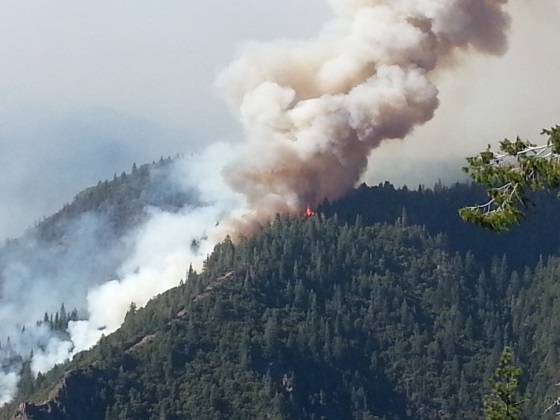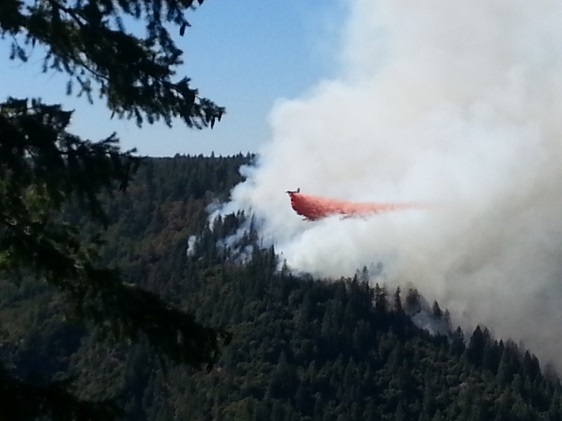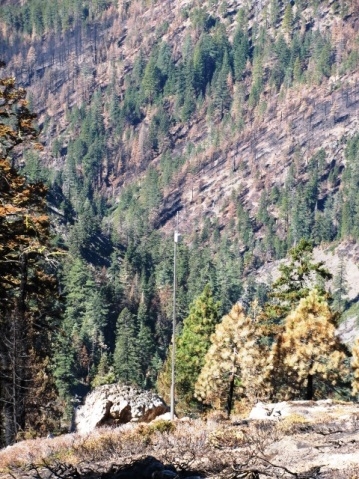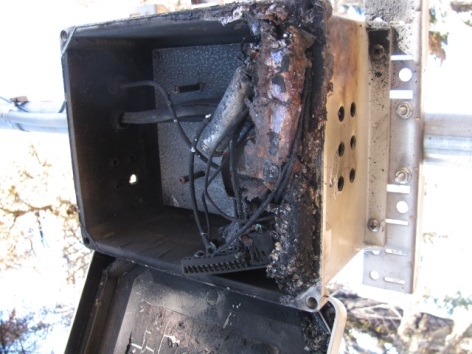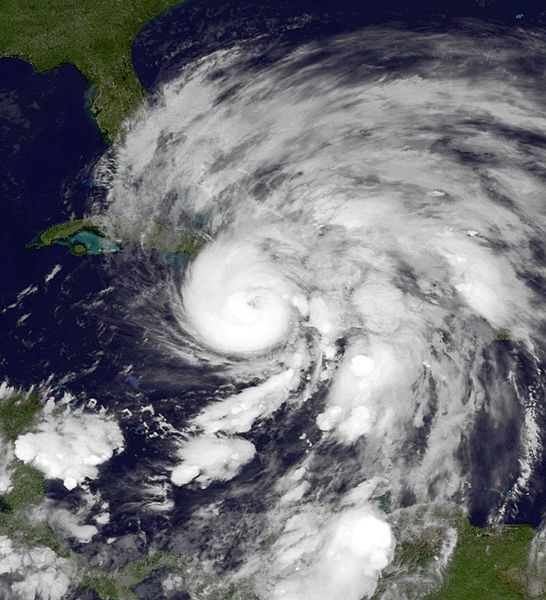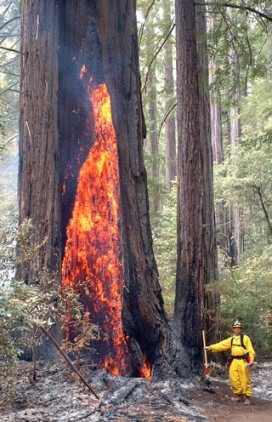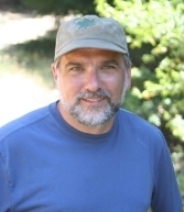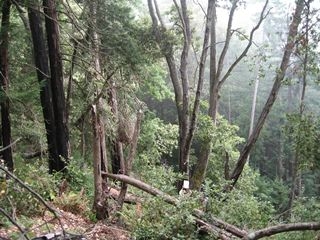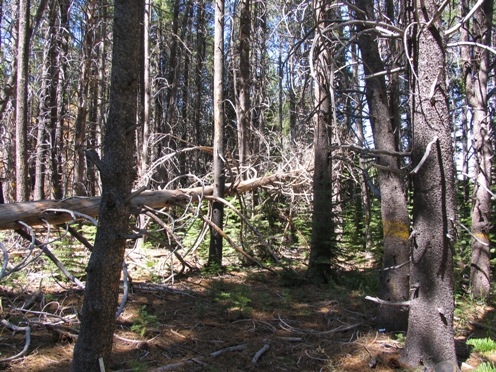Posts Tagged: wildfire
What happens when a wildfire sweeps through your study area?
On Aug. 10, 2013, a wildfire started in a steep canyon on the Tahoe National Forest. When it was finally declared controlled on Oct. 8, the 'American Fire' as it was named, had burned approximately 27,440 acres, including half (1,100 acres) of the Sierra Nevada Adaptive Management Project (SNAMP) Last Chance study site.
Initiated more than 7 years ago, SNAMP is a collaboration project involving the University of California, UC Cooperative Extension, the US Forest Service, other state and federal agencies and the public that explores the effects of fuels reduction or thinning projects conducted by the Forest Service on forest health, fire behavior, water quality and quantity, wildlife (California spotted owl and Pacific fisher) and public participation. Scientists are using data collected from treated and untreated areas to model potential impacts of forest management. For example, fire modeling is being done to simulate what could happen in the event of a fire on the landscape. All of the science teams are integrating their results to provide forest managers with information that is relevant at the fireshed scale for future projects.
Before the American Fire broke out, work by the Forest Service on the Last Chance project treatment areas was mostly completed, including commercial timber harvesting, post-harvest surface fuels treatment and more than three-quarters of the prescribed fire acreage. UC forest researchers had resurveyed 99 percent of treated and untreated forest plots and were out in the forest working to complete the remaining plots when the fire started. The owl team had completed their surveys for the year at Last Chance and in the surrounding areas that comprise the regional study areas. The water team had in-stream monitoring equipment in place, as well as meteorological stations at several locations, recording and relaying data to UC Merced.
After the American Fire ignited west of the SNAMP study site, American River Ranger District staff ordered all science teams working in the area to evacuate. They removed several of the water team's wireless nodes that were threatened, along with the stream level monitoring equipment. They covered other equipment with fire blankets and bulldozed a defensive line around a meteorological station to keep the fire out of the immediate area.
Parts of the treated and untreated study areas in the Last Chance project, including completed thinning and prescribed burning units, were burned in the American Fire. Some of this area was intentionally backfired by firefighters to aid in fire management. The vast majority of the treated area burned at low severity with pockets of moderate severity. The decision to backfire through the middle of the Last Chance project was a direct result of the project's location and post-treatment fuel profile.
The final determination of how the vegetation survived the fire will probably not be made for another year since significant mortality can happen much later. There was one active spotted owl nest site on the fire perimeter and it was known to have juvenile owls. The site will be surveyed by the owl team in 2014. As a result of quick action by the US Forest Service, only one of the water team's wireless nodes was damaged by fire.
The SNAMP project comes to an end this year. Science teams are working with post-treatment but pre-fire data to complete their analysis, write individual chapters and create integration products. However at the same time, the American Fire provides a unique but fleeting opportunity to empirically examine the effects of fuels treatments. Thus planning is underway for further research at Last Chance to examine how wildfire under current management can transform ecosystem functions, and how to obtain desired results through novel fire management strategies. Adaptive management is analysis of an action, incorporation of new findings and adapting existing actions based on those results. SNAMP scientists want to take full advantage of the learning opportunities provided by the investment in SNAMP and the impacts of the American Fire at Last Chance.
Links between extreme weather and climate change are tenuous
A steady stream of extreme weather events makes for a steady media drumbeat on climate change, but the stream can run dry, reported Richard Kerr. For example, the 2013 Atlantic hurricane season has produced just two short-lived, Category 1 hurricanes. Such mild weather can become an argument for climate skeptics.
The article opened with a quote from "a well-meaning non-scientist" who tried to use extreme weather to argue that global warming is real - President Obama.
"We can choose to believe that Superstorm Sandy, and the most severe drought in decades, and the worst wildfires some states have ever seen were all just a freak coincidence," Obama said in his State-of-the-Union address. "Or we can choose to believe in the overwhelming judgment of science - and act before it's too late."
Indeed, the evidence for climate change is unequivocal, "but the science linking any one hurricane, drought or flood to climate change is shaky, at best," the article said.
For commentary on climate change and wildfires, Kerr spoke to Max Moritz, UC Cooperative Extension specialist in the Department of Environmental Science, Policy and Management at UC Berkeley.
Moritz said it is plausible that a warming climate plays a role in fires in places like the western U.S. and Australia, but "fire is a couple steps removed from temperature and precipitation and our records are short. So detecting a trend is tough and attributing an event to climate change is really, really tough. We have to be very careful."
Climate change wields a double-edged sword in terms of fire
Climate change models predict more fires for the tinder-dry Western United States and high latitudes where carbon-rich peat soil will burn under extremely warm weather conditions. But some parts of the world will see less fire due to climate change, reported the New York Times.
That is because global climate models largely agree that areas near the Equator will see more precipitation with climate change, according to Max Moritz, UC Cooperative Extension specialist in the Department of Environmental Science, Policy and Management at UC Berkeley.
“This would — all other things being equal — tend to dampen prospects for fire in the equatorial rain forests,” Moritz said, adding that further research on seasonal precipitation patterns was needed.
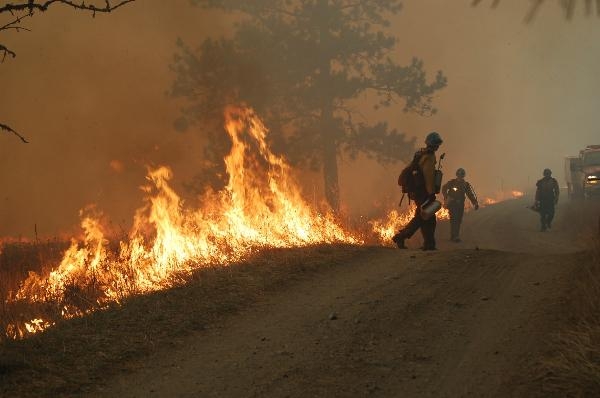
The Rim Fire near Yosemite may be a foretaste of major fires to come. (Photo: U.S. Forest Service.)
Coast redwoods increasingly susceptible to fire damage
California’s renowned coast redwood trees, previously believed to be fireproof, are now more than four times more susceptible to wildfire injury in coastal forest areas infested with the sudden oak death pathogen. These redwoods are now as susceptible to wildfires as other trees.
Millions of trees, including tanoaks, coast live oak, California bay laurels, and many other forest species have been killed by sudden oak death in coastal areas of central and northern California, and Oregon. The pathogen, Phytophthora ramorum, was first linked to the massive tree death in the mid-1990s.
David Rizzo, professor in the Department of Plant Pathology at UC Davis, and his research team are studying how the coastal forest ecology is changing since sudden oak death appeared, and why coast redwoods (Sequoia sempervirens) are subsequently so much more susceptible to fire.
It is the presence of the sudden oak death pathogen in forests that poses heavier fire risks for redwoods.
“If redwoods didn’t live in forests affected by the disease, they could withstand fires just fine,” says Margaret Metz, a postdoctoral research scholar working with Rizzo.
An initial explanation for the higher redwood mortality following wildfires is heavier fuel loads (such as fallen, dead branches from tanoaks) in forests affected by sudden oak death. Tanoak, Notholithocarpus densiflorus, is the primary host dying from sudden oak death and the main source of pathogen inoculum.
According to Rizzo, “The disease likely created more fuel for wildfires as dead tanoak branches fell. The loss of the oaks also would have decreased the amount of shade, drying out the forest and turning it into a tinder box, one not even redwoods could survive.”
A real key, though, is the finding that dead tanoaks, still standing, carry flames high into tree canopies, scorching the crowns of adjacent redwood trees. It’s this crown injury that is believed to have caused so many redwood trees to die in a number of fires that occurred in 2008.
Rizzo, noting that an increase in fire severity is resulting from climate change and global movement of species, says, “There may be all sorts of consequences, among them, dead and dying coast redwoods.”
Additional information:
- California's iconic redwoods in danger from fire and infectious disease. National Science Foundation report on Rizzo group’s work, August 2013
- The effects of sudden oak death and wildfire on forest composition and dynamics in the Big Sur ecoregion of coastal California. General technical report
- Ecology research article, Ecological Society of America
- California Oak Mortality Task Force website
Sierra forests need to burn more often
Many parts of the Sierra Nevada have not burned in more than 100 years, a significant departure from a natural fire cycle that would characterize a healthy forest, according to Susie Kocher, UC Cooperative Extension advisor in the Central Sierra office.
“The fire interval is completely out of whack compared to pre-settlement conditions,” Kocher said.
In a historical, natural and healthy fire regime, nearly half of Sierra forests would experience fire every 12 years and three-quarters would burn every 20 years. However, only 0.2 percent of Sierra forest land has burned repeatedly at least every 20 years in modern times, while 74 percent has not had a single wildfire or prescribed burn in the last 103 years.
These conclusions are part of a report Kocher produced for the Sierra Nevada Conservancy, a state agency created by the California legislature in 2004 with the understanding that the environmental, economic and social well-being of the Sierra Nevada and local communities would benefit from an organization providing strategic direction.
SNC commissioned reports about Sierra Nevada indicators, such as Demographics and the Economy, Land Conserved and Habitat, and Water and Air Quality and Climate. Kocher’s report is titled Forest Health and Carbon Storage. Future system indicator reports will cover Fire Threat and Agricultural Lands and Ranches.
Forest health is a particularly difficult indicator to frame and quantify as there is no consensus on exactly what defines forest health, Kocher writes in the introduction.
“Forest health is a concept that is commonly used but not well defined,” Kocher said. “You’d think you’d be able to answer how healthy a forest is in a straight forward way. But you have to look at stressors, the natural processes that are happening in a forest. What does the landscape look like?”
Because forest health cannot be characterized by any single, simple measure, Kocher selected three data sets to provide an indication of the health of forests in the region: fire return interval, wildfire threat to ecosystems and forest pest impact and threat. She found that fire return interval told the most provocative story.
Fire return interval tracks the frequency with which wildfire revisits the same land over and over. Kocher compared the frequency of fire return between the pre-settlement “natural” state and modern times.
The pre-settlement or “reference” fire return interval is an estimate of how often, on average, a given forest type likely burned in the three or four centuries prior to Euro-American settlement in the middle of the 19th century. As such, the reference state includes fires deliberately set by Native Americans to manage forest vegetation and wildlife.
Researchers determined fire frequency by analyzing fire scars in tree rings of live and dead trees. Results show that forested areas previously burned every 11 years on average in the warmer and drier lower elevation forests such as ponderosa pine. On the other end of the spectrum, fire occurred only every 133 years for sub-alpine forests where it takes much longer for fuels to accumulate and dry.
Fire suppression in the last 100 years has left much of the Sierra forest land vulnerable to high severity wildfire, Kocher wrote in her report. High severity wildfire across wide areas poses a threat to forest plant and animal life, to forest communities and watershed function, particularly in the northern half of the Sierra Nevada Conservancy Region.
Kocher’s report also reviewed carbon storage in Sierra Nevada forests. Since carbon in the atmosphere is leading to global climate change, there is increased interest in storing carbon in forests.
“It could be said that by suppressing fire, we have sequestered more carbon,” Kocher said. “In an overstocked forest, there are more standing trees and more fuel on the ground. Storing more carbon may help in the short run, but in the long term, your stand has a higher risk of burning up. That puts a lot of carbon into the atmosphere.”
Forest thinning improves the stability of carbon storage in the long-term. Whether it reduces the amount of carbon stored depends on what factors are taken into consideration, Kocher suggests. Part of the complexity of the equation stems from whether or not forest products removed from the forest are factored in. Most studies that account for the carbon sequestered by lumber and other products removed during thinning find that thinning both increases the quantity and stability of carbon sequestered by forests over time.


